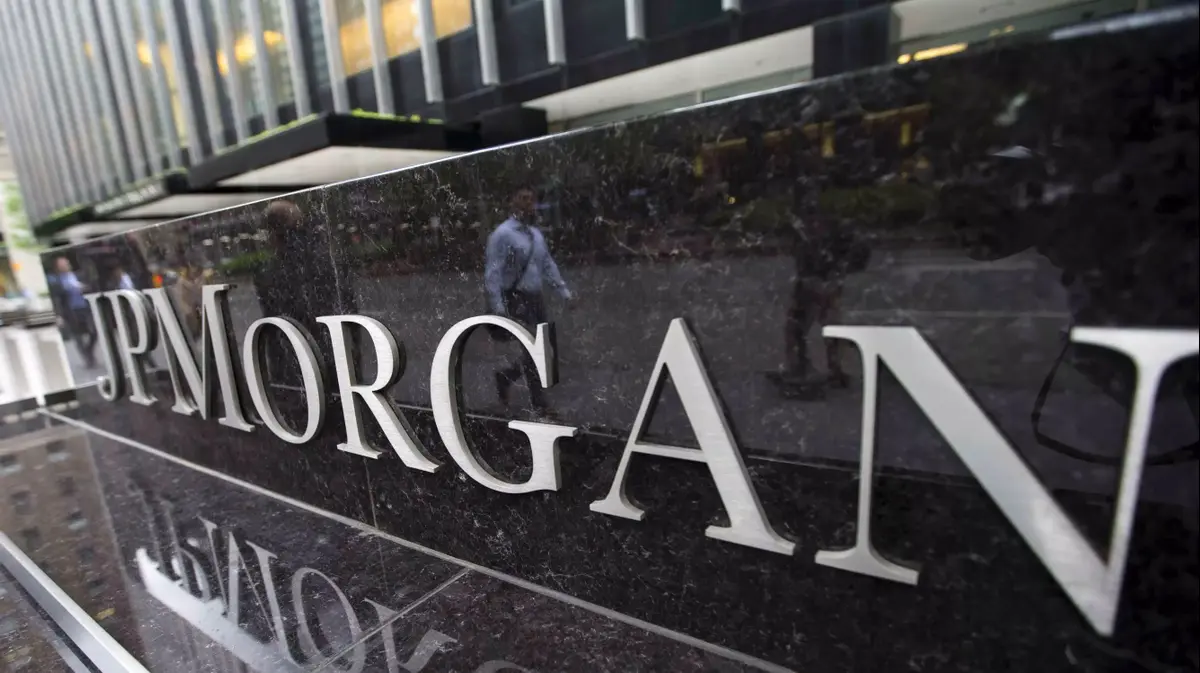JP Morgan, the largest bank in the USA. Why did its stock go down despite the increase in interest rates? (Photo: Reuters)
The spiral into which the bank stocks entered with the fall of the 'high-tech bank', the name attributed to the American SVB bank as a result of its focus on providing financial services to start-up and technology companies, was revealed mainly as investor panic over the approaching recession and did not prevent Jerome Powell, the chairman of the Federal Reserve (the central bank of the USA "b) to announce an additional interest rate increase of 0.25%.
Inflation data, as well as bank stock trading data, backs up the decision.
Examining the shares of the 5 largest American financial institutions traded on Wall Street have fallen an average of about 5.9% since SVB's announcement about the sale of debt assets and the need to raise money, while their total average decline since the end of March 2022, around the time of the first rate hike, is about 14.6% .
The decrease, therefore, has more to do with the trend of raising interest rates than with the bank whose conduct did not take it into account, but the big question that is floating in the air is how in a period of raising interest rates, which should be good for the banks' activity, the latter are falling.
The biggest decliners in the table were the bank shares of JP Morgan and Bank of America, which fell by approximately 10.8% and approximately 37.4% respectively since the end of March 2022, mainly due to fears of defaults by their customers, who will not be able to repay the loans they took.
But there were also those who were indifferent to changes in the form of the shares of the credit companies, the largest of which, Visa and Mastercard, showed a decrease of about 3.5% and about 4.5% in the last year, and this is mainly due to their activity as a clearinghouse and as those who do not provide loans and credit.
The largest financial institutions in the US. What happened to their shares? (Photo: Walla! system, without)
Uncertainty beats interest
Sergey Vaschunok, senior analyst at the Oppenheimer Investment House
: "The drop in stocks since the interest rate increase is particularly surprising in light of the fact that before the increase we were in a zero interest rate environment for about 14 years, which was bad for the banks. The
low interest rate reduced the possible profit margins for the banks, and also took deposits away from them who went out to look for yield outside, and also drove away companies that needed loans and financing, since they found it in the markets, in bonds for example, at a much cheaper interest rate than in the banks.
These led the American banks in general, to growth difficulties, and this oppressed their multipliers.
In the last year, however, the interest rate started to rise and theoretically this is one of the best things that happened to the financial institutions in the last decades, and this is also backed up by the results.
But for some reason this is not what is perceived in the eyes of investors, and the discourse emerging in the markets is that the increase in interest rates is not good for banks."
Vaschunok estimates that the investors' concerns lie in the uncertainty that still hovers over the world's largest economy, and mainly from its entry into recession, along with the lack of trust felt towards the American banking system, especially after the 2008 crisis. Vaschunok points out that "the discourse
surrounding the recession leads to preparations on the basis of It didn't happen. An examination of the data shows that for now the exact opposite is happening - people are consuming more and the American economy is growing both in real and nominal terms, and this despite the fact that inflation is still rearing its head, and it should be noted that it is already starting to slow down. The precipitation of 2008 Investors also fear that the Fed will be less aggressive in
the
process The interest rate increase. For example, he raised it by a quarter of a percent even though the expectation was for an increase of about half a percent. And if that is not enough, there is a trend of lowering the level of the American investor's holdings in the American banks, in light of the perception of risk that the former find in the latter, especially after the 2008 crisis.
But, it should be noted that the American financial system is much stronger than other similar systems in the world, such as the European one.
This is a system that undergoes an annual review by the Fed as if the economy is in a deep recession, and the return of all financial expenses that were during the Corona period is in evidence.
In this context, the fall of SVB is more related to SVB's own Heskey model, which is the opposite of a normal bank business model.
While a bank takes deposits from the public, pays a low interest rate on them - and that's only if it has to because it usually prefers that the funds sit in a bank account where it is not required to pay them for the money, and passes the money on as loans to the economy such as mortgages, business loans, etc., in SVB worked differently.
Silicon Valley Bank was mainly served by venture capital funds and high-tech companies, which in the last two years led to the entry of many funds into its deposits, and on which the bank paid relatively high interest rates in light of its customers who are aware of their financial strength.
More in Walla!
KKL-Junk encourages climate studies through scholarships for young students
In collaboration with KKL-Junk
Silicon Valley Bank.
Does not represent the banks in the USA (Photo: GettyImages, Justin Sullivan)
The "Hi-Tech Bank" does not represent
Deposits are the bank's liabilities side, against which it has to produce a side of assets such as loans, granted from the funds of those deposits.
As soon as the interest rate rises - the lenders should enjoy more.
But SVB did not do this, apparently thinking that it would be more efficient to keep the funds in cash.
When the fundraising wave ended, the flow of funds began to slow down, and as the high-tech companies began to use the funds they raised, the bank's deposits began to empty, with the portion of liabilities remaining high, and the portion of assets being relatively low.
About six months ago, our bank analyst dropped Oppenheimer's recommendation on the bank with a simple argument;
In the third quarter of 2022, the bank stated that they do not expect an increase in the credit margin.
And it didn't make sense, because when there is an increase in the interest rate there must be an improvement in the credit margin.
The excess interest must automatically roll over to the margin.
When it came out people began to realize that something was not working according to the model and began to worry.
However, SVB has no implications for the US banking system or anything else.
Psychology took something related to one slot and put it on a completely different slot.
If we examine the 2 largest banks in the table, then JPMorgan is biased towards business and is the largest bank in the US, with the strictest credit policy and also the one that is considered the most orderly bank in the US.
It serves the higher segment of the business sector alongside a relatively large activity in investments and no significant activity in the mortgage market.
The drop in its stock is mainly motivated by the fear that there will be a chain reaction from the collapse of all the banks, and the SVB case reinforces this, even though they have nothing to do with each other.
The reason lies mainly in the lack of knowledge of what each bank's exposures are, to whom, and how it will be handled on Judgment Day."
Sergey Vaschunok, senior analyst at the Oppenheimer Investment House (photo: Public Relations)
The fear of the weak customers
And Sachunok goes on to another American bank: "Compared to JP Morgan, Bank of America is biased toward the weaker populations throughout the American nation, and it also has investment activities (former Merrill Lynch). The fear among its investors is mainly from an increased risk of insolvency in light of the type its customers.
Alongside all of this, it should be noted that the increase in insolvencies seen in the reports is slight and far below the average levels in a long-term view, and certainly compared to the crises of 2008 or the energy crisis in 2015-16. The story of Credit Suisse, for example, does add fuel to the fire,
but It is also not related to the American banking system. This is a bank that has known endless problems of slaughter, apparently, and others, and conducted itself under all criticism. The fact that the blow has come to it now is mainly due to the growing awareness of risk in times of crisis.
Alongside all of this, there is a trend of moving back to the growth portfolios, despite the relatively cheap prices today of the banks and real estate companies. The technology companies have returned to take the lead, and now everything will continue to be conducted around inflation and the interest rate that will try to stop it."
Of money
world money
Tags
banks
stock
interest




